Friday, August 31, 2007
Man fined for illegal excavations on San Carlos Reservation
[Source: The Phoenix Business Journal] -- A northeastern Arizona man has been ordered to pay $24,000 in federal fines for illegally digging for artifacts on an Indian reservation. Mark Anthony Brady of Springerville pleaded guilty to violating a federal law that prohibits digging for tribal artifacts on Indian lands. Brady was digging for artifacts at a prehistoric village site on the San Carlos Indian Reservation.
Bond funding proposed to improve interpretive features at Honey Bee Village
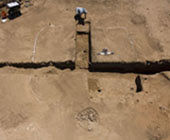 [Source: Danielle Sottosanti, Daily Star] -- Pima County and Oro Valley officials are deciding whether a $250,000 bond for Honey Bee Village should be on the ballot for the 2008 county bond election. Honey Bee Village is what remains of a Hohokam settlement located in Oro Valley east of North Rancho Vistoso Boulevard and south of the Moore Road alignment. The Hohokam first settled in the village, which was along the Honey Bee Wash in the Cañada del Oro Valley, around A.D. 450, according to the Center for Desert Archaeology. The county currently owns the 13-acre core of the site and intends to turn it over to the town, said Sarah More, Oro Valley's planning and zoning director.
[Source: Danielle Sottosanti, Daily Star] -- Pima County and Oro Valley officials are deciding whether a $250,000 bond for Honey Bee Village should be on the ballot for the 2008 county bond election. Honey Bee Village is what remains of a Hohokam settlement located in Oro Valley east of North Rancho Vistoso Boulevard and south of the Moore Road alignment. The Hohokam first settled in the village, which was along the Honey Bee Wash in the Cañada del Oro Valley, around A.D. 450, according to the Center for Desert Archaeology. The county currently owns the 13-acre core of the site and intends to turn it over to the town, said Sarah More, Oro Valley's planning and zoning director. The matter has to be resolved through an intergovernmental agreement, she said. Those 13 acres are meant to become a public preserve, both town and county officials said. "The 2008 proposal is to make that site accessible to the public," said Roger Anyon, cultural resources program manager for the county's Cultural Resources and Historic Preservation Office. If approved, most of the bond money would go toward creating trails and interpretative signs, he said. The money could also pay for erosion control and repair work, More said. Even though the county owns the land, putting the bond project on a list of recommended projects for the 2008 election requires the Oro Valley Town Council's approval because the site is within the town's limits, he said.
[Note: To read the full article, click here. Photo source: Center for Desert Archaeology.]
Mesa Grande Temple Mound exhibit offers look into history
[Source: Srianthi Perera, Arizona Republic] -- Before traveling to Mexico or Egypt to view ancient temples, check out the one in your backyard. The Mesa Grande Temple Mound is a well-preserved Hohokam site in the Southeast Valley. It's open only on special occasions, and from outside the enclosure, may seem just a dusty and creosote bush-covered mound, but an upcoming exhibit at Mesa Southwest Museum promises fresh insight into the spiritual side of Hohokam life. "It was a religious place just like the Mexican pyramids," said Jerry Howard, curator of anthropology, who found long passageways, secret rooms, a back entryway and plaza buried in the mound. These areas would have been used for preparation of religious rituals and worshipping, he said. The excavations and research of 20 years at the temple site, as well as at the Rowley (on Horne Road near the Park of the Canals) and Pew (at Alma School Road and Main Street) Hohokam sites in Mesa, will be presented in "Hohokam! Ancient Monuments of the Salt River Valley" beginning Oct. 3.
[Note: To read the full article, click here.]
[Note: To read the full article, click here.]
Wednesday, August 29, 2007
Oro Valley cowboy breakfast celebrates historic ranch's salvation
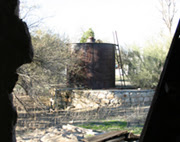 [Source: Walt Nett, Explorer News] -- From the way his grandson talked of the old days at Steam Pump Ranch, George Pusch would have approved of the shindig on the lawn. “This place was a busy place,” Hank Zipf recalled Wednesday morning as more than 100 guests gathered for a cowboy breakfast to celebrate Oro Valley’s acquisition of the historic ranch. “There was an old dirt road then, and anyone passing by was invited in for a drink of water, sometimes whiskey,” said Zipf, a former Oro Valley council member now retired and living in Tubac. Zipf said the ranch, one of two his grandfather owned in Southern Arizona, attracted a variety of visitors. In addition to ranchers who watered livestock there, prospectors would come in for provisions, and on occasion, a troop from the Army’s Fort Lowell would visit. The ranch gained its fame and attraction as the first ranch in the area to draw water with a steam pump. Oro Valley officials have been working to acquire the land and save the ranch since 2004 when a developer proposed razing the structures and creating a commercial facility. The town announced in late April that it was wrapping up the purchase, made with $3 million in Pima County bond funds that were originally earmarked for the Naranja Town Site.
[Source: Walt Nett, Explorer News] -- From the way his grandson talked of the old days at Steam Pump Ranch, George Pusch would have approved of the shindig on the lawn. “This place was a busy place,” Hank Zipf recalled Wednesday morning as more than 100 guests gathered for a cowboy breakfast to celebrate Oro Valley’s acquisition of the historic ranch. “There was an old dirt road then, and anyone passing by was invited in for a drink of water, sometimes whiskey,” said Zipf, a former Oro Valley council member now retired and living in Tubac. Zipf said the ranch, one of two his grandfather owned in Southern Arizona, attracted a variety of visitors. In addition to ranchers who watered livestock there, prospectors would come in for provisions, and on occasion, a troop from the Army’s Fort Lowell would visit. The ranch gained its fame and attraction as the first ranch in the area to draw water with a steam pump. Oro Valley officials have been working to acquire the land and save the ranch since 2004 when a developer proposed razing the structures and creating a commercial facility. The town announced in late April that it was wrapping up the purchase, made with $3 million in Pima County bond funds that were originally earmarked for the Naranja Town Site.[Note: To read the full article, click here. Photo source: Explorer News.]
Casa Grande Ruins marks 115 years of protection
 [Source: TriValleyCentral.com] -- Last June, the local landmark celebrated 115 years as nationally protected grounds. In fact, Casa Grande Ruins was the first prehistoric and cultural site to be established in the United States. The Casa Grande represented the centerpiece of the Hohokam irrigation farming culture, which flourished in the Gila River Valley beginning sometime between 300 B.C. and 300 A.D. By the Classic Period (1100-1450 A.D.), experts believe that anywhere from 5,000 to 10,000 Hohokam inhabited the area, living along 300 miles of canals dug from the Gila River.
[Source: TriValleyCentral.com] -- Last June, the local landmark celebrated 115 years as nationally protected grounds. In fact, Casa Grande Ruins was the first prehistoric and cultural site to be established in the United States. The Casa Grande represented the centerpiece of the Hohokam irrigation farming culture, which flourished in the Gila River Valley beginning sometime between 300 B.C. and 300 A.D. By the Classic Period (1100-1450 A.D.), experts believe that anywhere from 5,000 to 10,000 Hohokam inhabited the area, living along 300 miles of canals dug from the Gila River.Successful farming bred advanced architecture, as the Hohokam created building material by combining river water with desert earth, a material known as "caliche." The Hohokam started a practice of building earthen platform mounds every two to four kilometers along the river. The monstrous Casa Grande was built around 1300 A.D. But a lengthy drought, followed by a series of intense floods, destroyed the Hohokam farming network. The culture essentially disappeared around 1450 A.D., leaving behind little more than caliche ruins.
[Note: To read the full article, click here. Photo source: National Parks Service.]
Saturday, August 25, 2007
Superior's Magma Hotel for sale
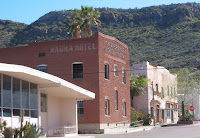 The historic Magma Hotel in Superior is up for sale (asking price $245,000). Listed on the National Register of Historic Places, the Magma Hotel is a cornerstone of current efforts to revitalize downtown Superior.
The historic Magma Hotel in Superior is up for sale (asking price $245,000). Listed on the National Register of Historic Places, the Magma Hotel is a cornerstone of current efforts to revitalize downtown Superior.The property has been vacant for 20 years and requires significant rehabilitation work. While the brick and concrete buildings appear to be structurally sound (per visual inspection from a licensed engineer), the adobe building has failed structurally and has partially collapsed in the rear. Interior conditions vary in the brick and concrete structures, tending to be better toward the south end of the buildings and worse at the north end, where rooms have taken on water damage. Roofs require stabilization.
For more information, contact Pamela Dalton-Robago at 520-689-5201 or e-mail.
Sunday, August 19, 2007
Downtown Phoenix vintage buildings dodge the wrecking ball
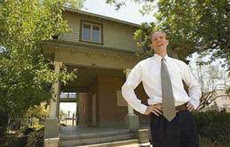 [Source: Jahna Berry, Arizona Republic] -- These days, it's either move it or lose it, downtown Phoenix preservationists say. It's becoming more common for residents, with the city's help, to pluck vintage buildings out of the path of development and put them in new neighborhoods. Moving an entire building used to be rare in Phoenix. The process was so complex and expensive that usually only one building moved each year. That's changing. Downtown Phoenix land values have skyrocketed, and many old buildings sit on prime real estate.
[Source: Jahna Berry, Arizona Republic] -- These days, it's either move it or lose it, downtown Phoenix preservationists say. It's becoming more common for residents, with the city's help, to pluck vintage buildings out of the path of development and put them in new neighborhoods. Moving an entire building used to be rare in Phoenix. The process was so complex and expensive that usually only one building moved each year. That's changing. Downtown Phoenix land values have skyrocketed, and many old buildings sit on prime real estate.[Editor's Note: Dan Klocke has let us know that the move date has been pushed back a tad to the weekend of September 7/8.]
Arizona State University's new downtown campus, a $600 million Phoenix Convention Center expansion, light-rail construction and condo high-rises have ignited a building boom. Some high-profile demolitions -- including Madison Square Garden, a 1929 former boxing arena in downtown Phoenix that was razed in 2005 -- also have increased public pressure to save rare buildings. Plus, more city leaders want to see new uses for vintage spaces in the downtown development mix. "We have moved more homes in the past five years than we have in the past 45," said John McCollough of McCollough Move-A-Home, a firm that has been moving buildings for more than four decades. McCollough estimates that his company has moved 100 houses in the Phoenix area in the past five years.
[Note: To read the full article, click here. Photo source: Tom Tingle, Arizona Republic. Caption: "Dan Klocke will have this historic Phoenix home moved to a new location."]
Friday, August 17, 2007
What are Phoenix's "Mid-Century Marvels"?
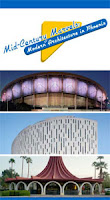 The City of Phoenix Historic Preservation Office's "Mid-Century Marvels" brochure is now available online in PDF format. Click here to download.
The City of Phoenix Historic Preservation Office's "Mid-Century Marvels" brochure is now available online in PDF format. Click here to download.Several "recent past" residential and commercial projects are also highlighted in the HP Office's "2004-2006 Progress Report." Click here to download.
Thursday, August 16, 2007
Hohokam temple park still on Mesa’s wish list
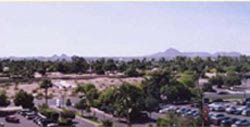 [Source: Sarah N. Lynch, Tribune] -- Archaeologist Jerry Howard has dreamed for years of transforming the Mesa Grande ruins near Brown Road in Mesa into a park for the public. The site is home to the ancient temple grounds of the Hohokam Indians, and it’s listed in the National Register of Historic Places. Mesa has owned the land since 1985, and archaeologists and volunteers from the Mesa Southwest Museum have been studying and preserving the land for more than two decades. But today, there is still a lack of funding for the park and the plan remains in limbo. The proposal has sat on a waiting list of capital improvement projects for more than 21 years. “It’s our greatest accomplishment,” Howard said, referring to public ownership of the mound. “But it’s also our greatest pain.” The holdup, as usual, is money.
[Source: Sarah N. Lynch, Tribune] -- Archaeologist Jerry Howard has dreamed for years of transforming the Mesa Grande ruins near Brown Road in Mesa into a park for the public. The site is home to the ancient temple grounds of the Hohokam Indians, and it’s listed in the National Register of Historic Places. Mesa has owned the land since 1985, and archaeologists and volunteers from the Mesa Southwest Museum have been studying and preserving the land for more than two decades. But today, there is still a lack of funding for the park and the plan remains in limbo. The proposal has sat on a waiting list of capital improvement projects for more than 21 years. “It’s our greatest accomplishment,” Howard said, referring to public ownership of the mound. “But it’s also our greatest pain.” The holdup, as usual, is money. The city this year will apply for $600,000 in Indian casino funds to help get the overdue project off the ground. The money would be used to build interpretive trails, signs, shade shelters and to pay for a study that would lead to an educational visitors center, said Tom Wilson, director of the Mesa Southwest Museum. The park enhancements would cost $5 million or more. When finished, it would be similar to the Pueblo Grande public recreation site in Phoenix. Mesa and museum officials hope to someday build an environmentally friendly 30,000-square-foot visitors center with exhibits on the Hohokam tribe, trails, parking and restrooms.
[Note: To read the full article, click here. Photo source: Tom Jonas.]
Sedona's Ernst/Tanning house spared
[Source: Bill Gunning, Friends of Capricorn] -- The owners of the Ernst/Tanning house have upgraded the home and are renting it out to artists. Arizona State University held an informal meeting of international scholars at the house on Capricorn Hill this year. People seem to agree that the house should be restored to a pre-1960 condition. The hope is to have another opportunity for this preservation effort while looking at other options. One option is to establish a small Museum of Art for Sedona that would celebrate all the artists that have called Sedona home. The Museum would feature Max Ernst and Dorothea Tanning and their house on Capricorn Hill. By calling attention to the artists through their art and the actual artists studios built in Sedona, the public would be better educated to participate in area preservation efforts.
Wednesday, August 15, 2007
How to make Pinal a paradise, in 17 steps
 [Source: Grady Gammage Jr. and Nancy Welch of ASU's Morrison Institute via Tucson Citizen] -- Pinal County wants to be a distinctive place. Pinal County wants strong family-friendly communities -- plus good jobs, easy mobility, and lots of open spaces.
[Source: Grady Gammage Jr. and Nancy Welch of ASU's Morrison Institute via Tucson Citizen] -- Pinal County wants to be a distinctive place. Pinal County wants strong family-friendly communities -- plus good jobs, easy mobility, and lots of open spaces."The Future at Pinal: Making Choices, Making Places" report offers 17 "cool tools" to turn Pinal's wants into realities. Ready to use as is, be made better or mix and match, these ideas could revolutionize development in Pinal and throughout Arizona or inspire even more creative options.
Among the 17 steps is #9, "Use the 3Rs to fix it first: rehabilitate, renovate, and restore would be Pinal's watchwords. Invest in city centers using the best techniques in historic preservation and redevelopment." [Note: To read the full article and review the other 16 steps, click here.]
Historic Tempe mill will see glass addition
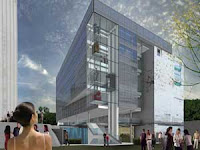 [Source: Ed Taylor, East Valley Tribune] -- One of the most historic buildings in Tempe will be revived and given a glass-enclosed addition, according to plans drawn up by architects for the dormant Hayden Flour Mill site. Tempe-based Avenue Communities, developer of the property, and its architecture firm, Substance Design Consortium, have produced renderings that show the mill building and its separate iconic silo structure retained in their existing form but with a five-story glass office building in between and wrapped on top on the mill.
[Source: Ed Taylor, East Valley Tribune] -- One of the most historic buildings in Tempe will be revived and given a glass-enclosed addition, according to plans drawn up by architects for the dormant Hayden Flour Mill site. Tempe-based Avenue Communities, developer of the property, and its architecture firm, Substance Design Consortium, have produced renderings that show the mill building and its separate iconic silo structure retained in their existing form but with a five-story glass office building in between and wrapped on top on the mill.Machinery once used to grind flour inside the mill will be displayed vertically at the northeast corner of the addition, visible through glass from a plaza below. Also the machinery would be visible from a glass-enclosed elevator, according to the plans, which have been approved by the Tempe Historic Preservation Commission.
The 1918 mill building -- not to be confused with the separate silo structure that was added in 1951 -- will contain a restaurant, retail stores, and offices. Archaeological structures, including an intact stone archway that straddled a canal once providing water power for the mill, will be preserved beneath the glassy addition. [Note: To read the full article, click here.]
Tuesday, August 14, 2007
City of Phoenix seeks Historic Preservation planner
 Salary Range: $52,603 – 74,755 annualized.
Salary Range: $52,603 – 74,755 annualized.Recruitment Dates: August 13 to September 10, 2007 (first review of applications)
Requires two years of experience performing public or private planning, preservation or architectural work plus a bachelor's degree in architecture, history, planning, historic preservation, archeology, or a closely related field. Knowledge of the Secretary of the Interior's Standards for Rehabilitation, historic architectural styles and building construction techniques is essential. Strong writing and communication skills and experience in working with government, non-profit boards and commissions is desirable. Experience managing historic rehabilitation projects, performing federal compliance work, and overseeing grant programs are preferred. Other combinations of experience and education that meet the minimum qualifications may be substituted.
Coordinates and assists in the implementation of the City's Historic Preservation Program. Prepares and processes historic preservation zoning cases; performs design reviews of Certificate of Appropriateness applications; manages major rehabilitation work on city-owned historic sites; reviews city projects for compliance with city, state and federal historic preservation regulations; performs historic research and survey work; helps to manage historic preservation incentive programs; performs public outreach; prepares reports and makes public presentations; enforces the city historic preservation ordinance; and provides technical, architectural and historical design guidance to City staff, elected officials, citizens, boards and commissions.
Some positions in this classification require the use of personal or City vehicles on City business. Individuals must be physically capable of operating the vehicles safely, possess an appropriate valid Arizona driver's license, possess personal insurance coverage, and have an acceptable driving record.
Based on resume and cover letter. In your cover letter or resume, please describe your knowledge of the Secretary of the Interior's Standards for Rehabilitation, historic architectural styles, building construction techniques, and all other related historic preservation experience. Only applicants who meet the experience requirements will be placed on the eligible-to-hire list. Previous score cannot be reused.
The City of Phoenix supports a drug-free workplace. After an employment offer is made, external applicants will be required to take and pass a drug test. Employment will be contingent upon successful completion of this drug test, and consideration of background, reference, and other job-related selection information. For more information, click here.
Wednesday, August 08, 2007
Opus West hopes Phoenix neighborhood negotiations put project back on track
 [Source: Jan Buchholz, Phoenix Business Journal] -- Opus West, which had its plans for a mixed-use development project on the southeast corner of Camelback Road and 44th Street shot down at the July 10 meeting of the Camelback East Village Planning Committee, has decided to renegotiate with neighbors and delay meeting with the Phoenix Planning Commission until September. "We pushed that out 30 days. We want to assess where everybody's at," said Jeff Roberts, Opus West vice president of real estate development.
[Source: Jan Buchholz, Phoenix Business Journal] -- Opus West, which had its plans for a mixed-use development project on the southeast corner of Camelback Road and 44th Street shot down at the July 10 meeting of the Camelback East Village Planning Committee, has decided to renegotiate with neighbors and delay meeting with the Phoenix Planning Commission until September. "We pushed that out 30 days. We want to assess where everybody's at," said Jeff Roberts, Opus West vice president of real estate development. Opus West hoped to rezone a 1.4-acre parcel of land to the east of the current Chase Bank building (pictured) to allow for a four-story condominium project with boutique retail, but the neighborhood planning committee, which makes recommendations to the Phoenix Planning Commission, voted 11-5 against the proposal. "We were a little disappointed. It was obvious after the fact that people had made up their minds before we made our presentation at the meeting," Roberts said. After talking with members of the planning commission and city staff, Roberts said Opus executives are willing to try to come up with a compromise plan. "There's a leadership group being put in place that we can negotiate with," Roberts said. Roberts said the city is putting together the group that will include neighborhood representatives and historic preservationists who remain concerned about the future of the Chase Bank building, which is considered a design icon of the 1960s. "We'll try to find some common ground," he said.
[Note: To read the full article, click here. Photo source: Walt Lockley.]
Rural tourism development grant program guidelines for fiscal year 2008
[Source: Arizona Office of Tourism] -- The Rural Tourism Development Grant Program (RTDGP) guidelines for FY08 are now available. The primary objective of this competitive grant program is to provide coordinated funding for tourism related infrastructure projects in rural communities throughout the State. The funding amount for FY08 is $550,000. These funds assist rural economic development through tourism to strengthen the regional and local economies and expand tourism in rural and Tribal communities throughout Arizona. The primary function of the infrastructure project must be tourism development and the project must be designed to initiate economic growth and enhance future tourism development. Applications are available on AOT’s business-to-business Web site under the Grants section. Applications must be received by the Arizona Office of Tourism no later than 5 p.m. Thursday, August, 30, 2007. If you have any questions, please feel free to contact Karen McClurg, Tourism Education and Development Manager at kmcclurg@azot.gov or by phone at 602-364-3708.
Tumacacori wilderness sought
 [Source: Tony Davis, Daily Star] -- The debate over a proposed Tumacacori Highlands wilderness area swings into high gear now that U.S. Rep. Raúl Grijalva has introduced a bill to protect 83,400 acres of national forest from Tubac south to the Mexican border. Although they face opponents who cite border-enforcement concerns, Grijalva and environmentalists have lined up a broad coalition of supporters in four years of planning. Backers include four hunting groups, two religious groups, four neighborhood associations and dozens of businesses from Tubac to Nogales. They're joined by 80 University of Arizona scientists who say the Tumacacori Highlands need protection from increasing urbanization in the Upper Santa Cruz River Valley and the Tucson area to the north. In particular, the area must be protected to keep a growing number of off-road vehicles from scarring a lush and fragile landscape, wilderness supporters say. The area plays host to an immense variety of state and federally protected species — 74 in all — and some of the Southwest's most rugged and biologically diverse wildlands. [Note: To read the full article, click here.]
[Source: Tony Davis, Daily Star] -- The debate over a proposed Tumacacori Highlands wilderness area swings into high gear now that U.S. Rep. Raúl Grijalva has introduced a bill to protect 83,400 acres of national forest from Tubac south to the Mexican border. Although they face opponents who cite border-enforcement concerns, Grijalva and environmentalists have lined up a broad coalition of supporters in four years of planning. Backers include four hunting groups, two religious groups, four neighborhood associations and dozens of businesses from Tubac to Nogales. They're joined by 80 University of Arizona scientists who say the Tumacacori Highlands need protection from increasing urbanization in the Upper Santa Cruz River Valley and the Tucson area to the north. In particular, the area must be protected to keep a growing number of off-road vehicles from scarring a lush and fragile landscape, wilderness supporters say. The area plays host to an immense variety of state and federally protected species — 74 in all — and some of the Southwest's most rugged and biologically diverse wildlands. [Note: To read the full article, click here.]
Shutdown of Tucson eatery dents downtown rehab efforts
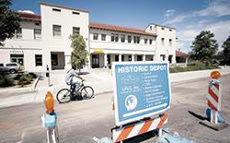 [Source: Rob O'Dell, Daily Star] -- Even by Rio Nuevo standards, the $12 million restoration of the Historic Train Depot Downtown has never been a huge draw for visitors and shoppers. Now its star tenant — lured by the city with heavily subsidized rent and taxpayer-funded renovations — has closed its doors indefinitely and is considering suing the city because road construction Downtown hurt business. The restoration was supposed to attract offices, shops, a museum and restaurant — and most importantly, people — to the depot. Central Bistro's closing leaves the depot with a collection of offices and a rental car agency.
[Source: Rob O'Dell, Daily Star] -- Even by Rio Nuevo standards, the $12 million restoration of the Historic Train Depot Downtown has never been a huge draw for visitors and shoppers. Now its star tenant — lured by the city with heavily subsidized rent and taxpayer-funded renovations — has closed its doors indefinitely and is considering suing the city because road construction Downtown hurt business. The restoration was supposed to attract offices, shops, a museum and restaurant — and most importantly, people — to the depot. Central Bistro's closing leaves the depot with a collection of offices and a rental car agency. Sonia Economou, co-owner of Central Bistro, which opened inside the depot in early 2006, said the restaurant closed its doors because of the construction of the Fourth Avenue underpass and open trenching along Toole Avenue in front of their business. "We can't get people to understand we're there and open," Economou said. "We're losing money staying open." Economou said the Fourth Avenue construction "alone has been pretty devastating to us," but the trenching on Toole is what got the restaurant considering legal action against the city. "Our lawyers are looking at it," Economou said. "We feel deceived by what was happening down there. The Toole Avenue construction was a slap in the face."
[Note: To read the full article, click here. Photo source: Kelly Presnell, Daily Star.]
Smithsonian director delivers high praise for Bisbee museum
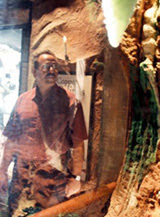 [Source: Shar Porier, Herald/Review] -- “The Smithsonian is proud of the outcome of this exhibit.” So said Smithsonian Affiliations Director Harold A. Closter Thursday morning as he took a tour of the award-winning exhibit titled “Digging In: Bisbee’s Mineral Heritage”. It was the first time Closter had seen the finished product that was the result of a collaborative effort between the Smithsonian and the Bisbee Mining and Historical Museum that took many months of painstaking work. The Smithsonian provided many of the mineral specimens on display, as well as the know-how for the lighting of the specimens and even built the “cave” with its beautiful stalactites and stalagmites. “This is fantastic,” he said. “It’s a very powerful educational experience.” He commended the staff, board and supporters on the two awards the museum recently received for the exhibit. The American Association of State & Local History presented the museum Director Carrie Gustavson with the 2007 Award of Merit for Leadership in History.
[Source: Shar Porier, Herald/Review] -- “The Smithsonian is proud of the outcome of this exhibit.” So said Smithsonian Affiliations Director Harold A. Closter Thursday morning as he took a tour of the award-winning exhibit titled “Digging In: Bisbee’s Mineral Heritage”. It was the first time Closter had seen the finished product that was the result of a collaborative effort between the Smithsonian and the Bisbee Mining and Historical Museum that took many months of painstaking work. The Smithsonian provided many of the mineral specimens on display, as well as the know-how for the lighting of the specimens and even built the “cave” with its beautiful stalactites and stalagmites. “This is fantastic,” he said. “It’s a very powerful educational experience.” He commended the staff, board and supporters on the two awards the museum recently received for the exhibit. The American Association of State & Local History presented the museum Director Carrie Gustavson with the 2007 Award of Merit for Leadership in History.[Note: To read the full article, click here. Photo source: Beatrice Richardson, Herald/Review - Harold A. Closter, a director with Smithsonian Affiliations, views the Digging In exhibit at the Museum.]
Tuesday, August 07, 2007
City of Sedona grants available for historic preservation
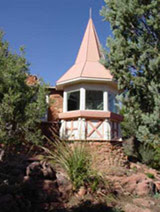 [Source: Sedona.biz] -- The City Council has appropriated $15,000 in fiscal year 2007-08 to implement a second year of the small grant assistance program for historic preservation. These grants will be given to the owners of a designated local landmark property, a structure or site eligible to be a landmark, and/or one that has been identified as historic. Last year, eight properties were awarded grants for restoration work including the Bela Horvath Home/Studio used by Unity Church, the Dr. H.H. Nininger and the DaVoss-Hawley homes, both private residences, and KSB’s offices, the historic Pushmataha building. The Historic Preservation Small Grant Assistance Program offers grants to property owners to restore, repair, rehabilitate maintain, preserve, and/or protect their properties (like the Unity Church, pictured, which received funding to repair and replace rotting fascia). This program will provide financial assistance to help owners improve the exterior of historic structures that are located in the City of Sedona, thus improving the overall historic character of the community. The program reimburses owners on a matching basis up to 50% of the cost for pre-approved work. The awards will be for a minimum of $1,000 to a maximum of $5,000. [Note: To read the full article, click here.]
[Source: Sedona.biz] -- The City Council has appropriated $15,000 in fiscal year 2007-08 to implement a second year of the small grant assistance program for historic preservation. These grants will be given to the owners of a designated local landmark property, a structure or site eligible to be a landmark, and/or one that has been identified as historic. Last year, eight properties were awarded grants for restoration work including the Bela Horvath Home/Studio used by Unity Church, the Dr. H.H. Nininger and the DaVoss-Hawley homes, both private residences, and KSB’s offices, the historic Pushmataha building. The Historic Preservation Small Grant Assistance Program offers grants to property owners to restore, repair, rehabilitate maintain, preserve, and/or protect their properties (like the Unity Church, pictured, which received funding to repair and replace rotting fascia). This program will provide financial assistance to help owners improve the exterior of historic structures that are located in the City of Sedona, thus improving the overall historic character of the community. The program reimburses owners on a matching basis up to 50% of the cost for pre-approved work. The awards will be for a minimum of $1,000 to a maximum of $5,000. [Note: To read the full article, click here.]
Union Pacific offers support, money for Willcox improvements
[Source: Carol Broeder, Arizona Range News] -- The Willcox City Council has given its official support to Union Pacific Railroad's track expansion through the city. In return, the railroad will assist in paying for city improvements in the historic downtown area that will be impacted by the proposed expansion. City administrators and Union Pacific officials have discussed areas of concern, such as the establishment of a quiet zone, drainage concerns, construction of public restrooms in Railroad Park, and renovation of the Mascot and Western railroad car. Union Pacific has indicated "a desire and a willingness" to assist the city in addressing these issues, and the financial commitment necessary for the city to undertake and complete these projects. The council voted unanimously at its July 16 meeting to support Union Pacific's application to the Arizona Corporation Commission (ACC) for the expansion of the proposed track system through city limits.
Hohokam canal site unearthed at ASU dig
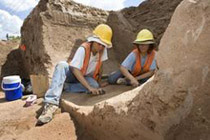 [Source: Kristi Eaton, Arizona Republic] --Archaeologists have uncovered canals dating back as far as the year 1000 on an Arizona State University construction site that was already embroiled in controversy. And like the iconic gold-domed Valley National Bank building torn down on the site in February, the canals on the northwestern corner of Apache Boulevard and Rural Road in Tempe will be destroyed to make way for a new residence hall and honors college. Samples were taken from the canals and will be sent to local laboratories for analysis. Pottery found at the site will be given to ASU's Archaeological Research Institute. The canals, which have three soil marks indicating different time periods, will be filled in to construct the $100 million Barrett Honors College. "What we're after is data," said Glen Rice of Rio Salado Archaeology and an ASU emeritus faculty member in the School of Human Evolution and Social Change. "We're not after the objects per se." The two canals from the Hohokam time period were unearthed in July at the site.
[Source: Kristi Eaton, Arizona Republic] --Archaeologists have uncovered canals dating back as far as the year 1000 on an Arizona State University construction site that was already embroiled in controversy. And like the iconic gold-domed Valley National Bank building torn down on the site in February, the canals on the northwestern corner of Apache Boulevard and Rural Road in Tempe will be destroyed to make way for a new residence hall and honors college. Samples were taken from the canals and will be sent to local laboratories for analysis. Pottery found at the site will be given to ASU's Archaeological Research Institute. The canals, which have three soil marks indicating different time periods, will be filled in to construct the $100 million Barrett Honors College. "What we're after is data," said Glen Rice of Rio Salado Archaeology and an ASU emeritus faculty member in the School of Human Evolution and Social Change. "We're not after the objects per se." The two canals from the Hohokam time period were unearthed in July at the site. [Note: To read the full article, click here. Photo source: Arizona Republic.]
Subscribe to:
Posts (Atom)